Chicago, on Lake Michigan in Illinois, is among the largest cities in the U.S. Famed for its bold architecture, it has a skyline punctuated by skyscrapers such as the iconic John Hancock Center, 1,451-ft. Willis Tower (formerly the Sears Tower) and the neo-Gothic Tribune Tower. The city is also renowned for its museums, including the Art Institute of Chicago with its noted Impressionist and Post-Impressionist works.
On the shore of Lake Michigan, Chicago was incorporated as a city in 1837 near a portage between the Great Lakes and the Mississippi River watershed. It grew rapidly in the mid-19th century; by 1860, Chicago was the youngest U.S. city to exceed a population of 100,000. The Great Chicago Fire in 1871 destroyed several square miles and left more than 100,000 homeless but Chicago’s population continued to grow to 503,000 by 1880 and then doubled to more than a million within the decade.The construction boom accelerated population growth throughout the following decades, and by 1900, less than 30 years after the fire, Chicago was the fifth-largest city in the world.Chicago made noted contributions to urban planning and zoning standards, including new construction styles (such as, Chicago School architecture, the development of the City Beautiful Movement, and the steel-framed skyscraper).
1. Art Institute of Chicago
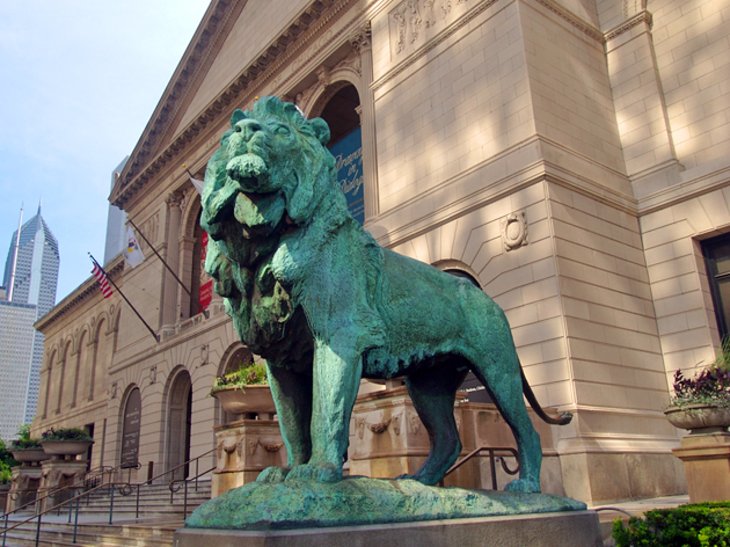
Renowned art museum holding nearly 300,000 works from all over the world, spanning many centuries.
the Art Institute of Chicago is a world class museum with hundreds of thousands of artworks. The diverse collection spans thousands of years and includes pieces from a variety of media including painting, prints, photography, sculpture, decorative arts, textiles, architectural drawings and more.
The Institute is known for its collection of impressionist and post-Impressionist paintings including Georges Seurat’s 1884 A Sunday Afternoon on La Grande Jatte, Renoir’s 1879 Acrobats at the Cirque Fernando, and numerous paintings by Claude Monet.
As a research institution, the Art Institute also has a conservation and conservation science department, five conservation laboratories, and one of the largest art history and architecture libraries in the country—the Ryerson and Burnham Libraries.
The growth of the collection has warranted several additions to the museum’s 1893 building, which was constructed for the World’s Columbian Exposition. The most recent expansion, the Modern Wing designed by Renzo Piano, opened in 2009 and increased the museum’s footprint to nearly one million square feet, making it the second-largest art museum in the United States, after the Metropolitan Museum of Art.The Art Institute is associated with the School of the Art Institute of Chicago, a leading art school, making it one of the few remaining unified arts institutions in the United States.
In 2017, the Art Institute received 1,619,316 visitors, and was the 35th most-visited art museum in the world. However, in 2020, due to the COVID-19 pandemic, the museum was closed for 169 days, and attendance plunged by 78 percent from 2019, to 365,660.
2. Navy Pier
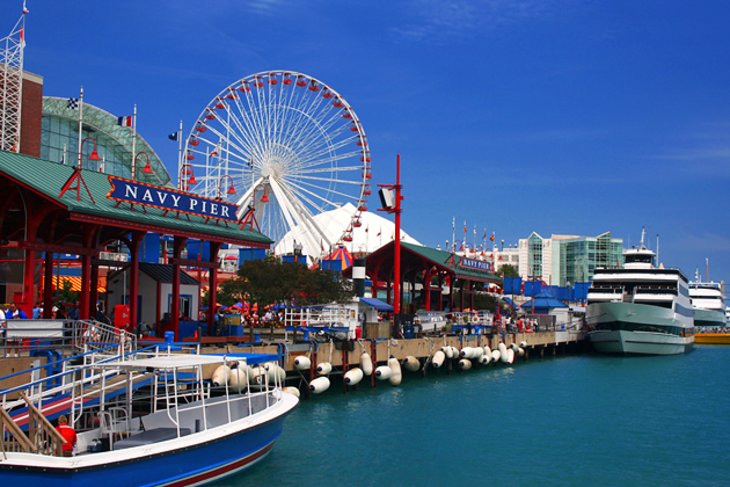
Navy Pier is a 3,300-foot-long pier on the shoreline of Lake Michigan, located in the Streeterville neighborhood of the Near North Side community area in Chicago, Illinois, United States.
The Navy Pier originally opened in 1916 as an amusement area and shipping facility but is now one of Chicago’s most popular tourist attractions. Today, the Navy Pier is made up of 50 acres of gardens, attractions, shops, restaurants, concert venues, and parks. There is a 150-foot Ferris wheel and an historic carousel in Navy Pier Park.
Visitors can also watch a film at the 3D Imax Theater, watch actors perform the classics at the Chicago Shakespeare Theater, or visit Crystal Gardens, a one-acre, six-story, indoor botanical garden. Also located here is the Chicago Children’s Museum. The Pier hosts year-round festivities, including the Chicago Festival in August. Cruise ships leave from here on various sightseeing excursions.
Navy Pier is a 3,300-foot-long (1,010 m) pier on the shoreline of Lake Michigan, located in the Streeterville neighborhood of the Near North Side community area in Chicago, Illinois, United States. Navy Pier encompasses over 50 acres (20 ha) of parks, gardens, shops, restaurants, family attractions and exhibition facilities and is one of the top destinations in the Midwestern United States, drawing over nine million visitors annually. It is one of the most visited attractions in the entire Midwest and is Chicago’s second-most visited tourist attraction.
3.Reach for the Stars at Adler Planetarium
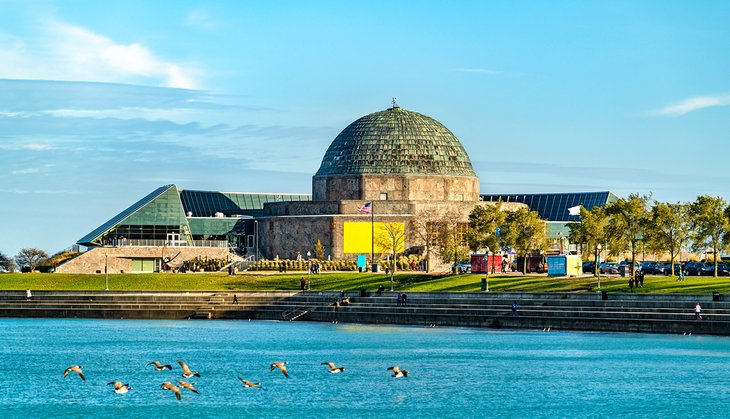
The Adler Planetarium is a public museum in Chicago, Illinois, dedicated to astronomy and astrophysics. It was founded in 1930 by local businessman Max Adler. Located on the northeastern tip of Northerly Island on Lake Michigan in the city, the Adler Planetarium was the first planetarium in the United States.
The Adler Planetarium is leaps and bounds beyond the ones most kids get to visit on school trips, and all ages will appreciate the shows and comprehensive exhibits it has to offer. The Adler prides itself in being the first planetarium in the Western Hemisphere, built in 1930 on the shore of Lake Michigan.
The planetarium is home to two dome theaters, which offer a variety of shows, including exploration of Chicago’s night sky, the solar system, and the moon. There is also an extensive array of exhibits that explore topics including life on other worlds, meteors and meteorites, space exploration, the history of the scientific discipline, and even the history of astrology.
Het Adler Planetarium and Astronomy Museum in Chicago (Illinois) was het eerste planetarium In de VS en is het oudste nog bestaande planetarium Het Adler werd in 1930 gebouwd door filantroop Max Adler, met hulp van de eerste directeur van het planetarium, Philip Fox. Door de ligging op het Northerly Island maakt het deel uit van de Museum Campus Chicago, samen met het Shedd Aquarium en het Field Museum of Natural History. In 1987 werd het tot National Historic Landmark verklaard.
Het Adler is het enige museum ter wereld met twee volledige planetariumtheaters. Sinds de opening in 1930 kunnen bezoekers representaties van de sterrenhemel zien in het historische Sky Theater-planetarium, waarvan de koepel van buitenaf te zien is.
4.Museum of Science and Industry
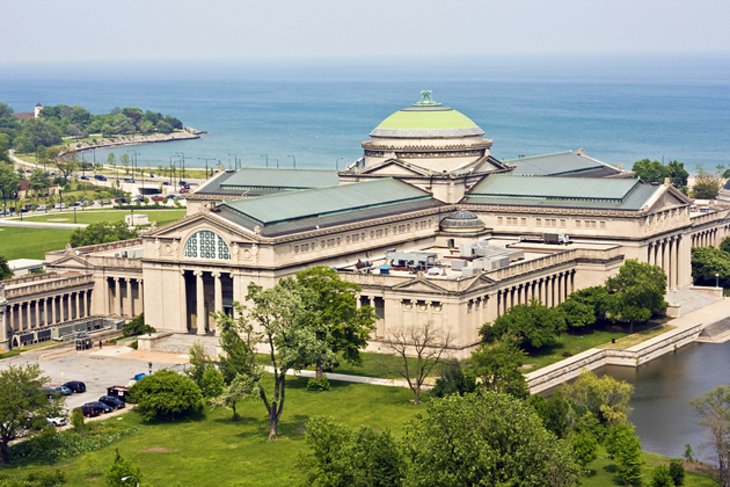
At the north end of Jackson Park is the Museum of Science and Industry, founded in 1933, and arguably the most impressive museum in Chicago. It is devoted to the application of natural laws in technological and industrial development.
The museum is thought to be the first in the U.S. to incorporate the idea of “hands-on” exhibits. Visitors are encouraged to interact with hundreds of exhibits. The MSI features permanent and changing exhibits, as well as an OMNIMAX theater.
The Museum of Science and Industry (MSI) is a science museum located in Chicago, Illinois, in Jackson Park, in the Hyde Park neighborhood between Lake Michigan and The University of Chicago. It is housed in the former Palace of Fine Arts from the 1893 World’s Columbian Exposition. Initially endowed by Julius Rosenwald, the Sears, Roebuck and Company president and philanthropist, it was supported by the Commercial Club of Chicago and opened in 1933 during the Century of Progress Exposition.
Among the museum’s exhibits are a full-size replica coal mine, German submarine U-505 captured during World War II, a 3,500-square-foot (330 m2) model railroad, the command module of Apollo 8, and the first diesel-powered streamlined stainless-steel passenger train.
5. Watch the Water Show at Buckingham Fountain
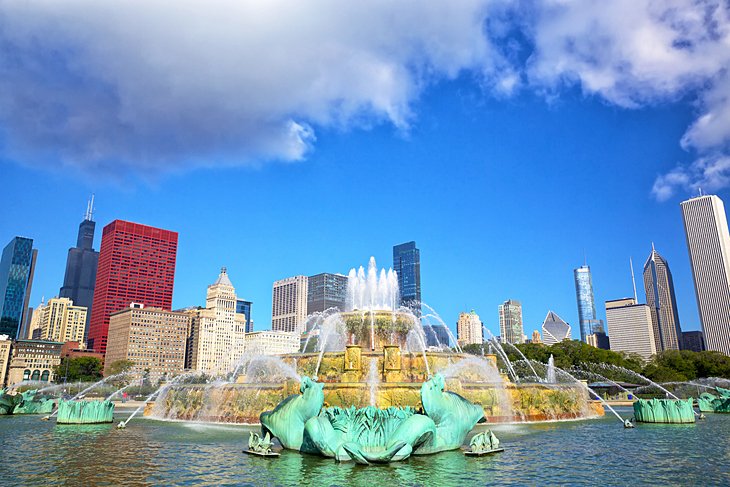
Buckingham Fountain is a Chicago Landmark in the center of Grant Park, between Queen’s Landing and Ida B. Wells Drive. Dedicated in 1927 and donated to the city by philanthropist Kate S. Buckingham, it is one of the largest fountains in the world.
Built in 1927 as a donation from the family, the Clarence Buckingham Memorial Fountain is one of the largest in the world. Designed in the period’s iconic Art Deco style, the central fountain is surrounded by four seahorses that represent Lake Michigan’s four bordering states. From 8am to 11pm, the fountain bursts to life hourly, shooting 15,000 gallons of water through nearly 200 nozzles each minute to create an impressive display.
Wells Drive. Dedicated in 1927 and donated to the city by philanthropist Kate S. Buckingham, it is one of the largest fountains in the world. Built in a rococo wedding cake style and inspired by the Latona Fountain at the Palace of Versailles, its design allegorically represents nearby Lake Michigan. The fountain operates from May to mid-October, with regular water shows and evening colored-light shows. During the winter, the fountain is decorated with festival lights.
6.Field Museum of Natural History
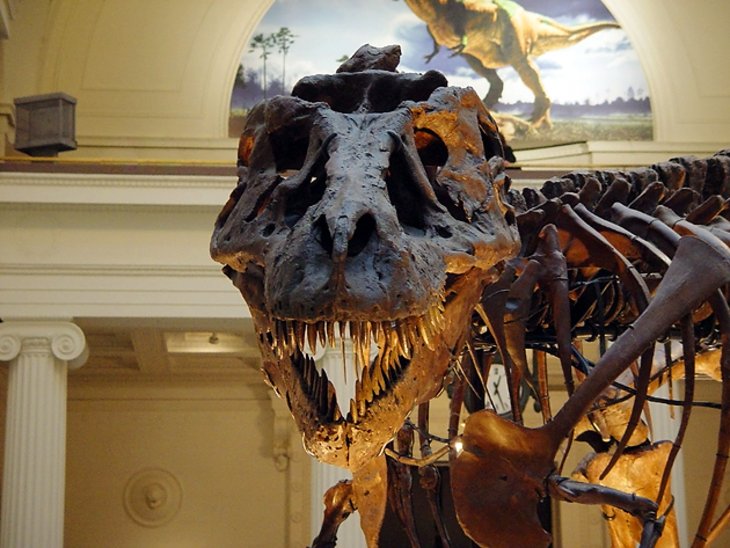
The Field Museum of Natural History, also known as The Field Museum, is a natural history museum in Chicago, Illinois, and is one of the largest such museums in the world.
The museum maintains a temporary exhibition program of traveling shows as well as in-house produced topical exhibitions. The professional staff maintains collections of over 24 million specimens and objects that provide the basis for the museum’s scientific-research programs These collections include the full range of existing biodiversity, gems, meteorites, fossils, and rich anthropological collections and cultural artifacts from around the globe The museum’s library, which contains over 275,000 books, journals, and photo archives focused on biological systematics, evolutionary biology, geology, archaeology, ethnology and material culture, supports the museum’s academic-research faculty and exhibit development.The academic faculty and scientific staff engage in field expeditions, in biodiversity and cultural research on every continent, in local and foreign student training, and in stewardship of the rich specimen and artifact collections. They work in close collaboration with public programming exhibitions and education initiatives.
Originally called the Columbian Museum of Chicago, the Field Museum of Natural History was founded in 1893 to showcase the biological and anthropological collections gathered for the World Columbian Exposition. The name changed in 1905 to honor Marshall Field, the department store owner, art patron, and major benefactor of the museum.
The permanent collection features approximately 20 million artifacts and specimens covering a variety of disciplines including geology, botany, zoology and anthropology. Of special note are the permanent displays on Ancient Egypt and the cultures of North, Central and South America and “Sue,” the world’s largest, most complete Tyrannosaurus rex skeleton. Special rotating exhibits take place on a regular basis throughout the year.
7.Lincoln Park
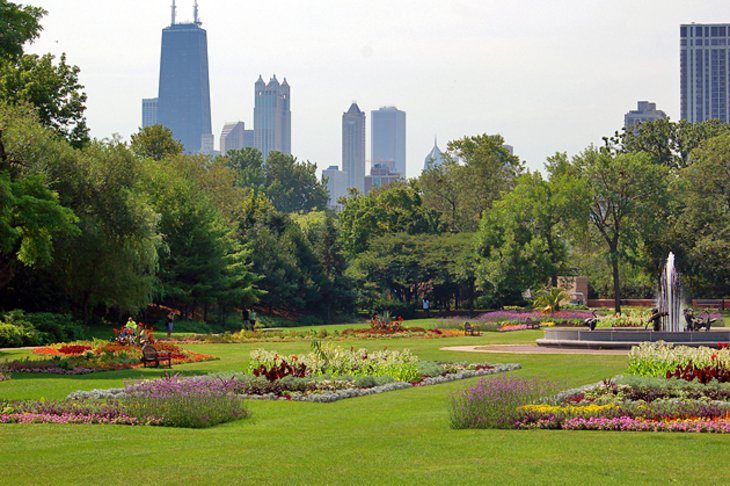
Lincoln Park is a six-mile stretch of green space along the edge of Lake Michigan, and Chicago’s biggest park. This popular park is home to the lovely Lincoln Park Conservatory and the Lincoln Park Zoo, one of the oldest zoos in the country. Also located here are the Peggy Notebaert Nature Museum, and the Chicago History Museum.
For those who simply want to enjoy the outdoor space there are playing fields, bike trails, jogging paths, and beaches. Visitors can see a number of significant statues and pieces of public art within the park grounds including Augustus Saint Gaudens’ Standing Statue of Lincoln (1887).
The band continued to explore a wider variation of musical types on their fourth album, A Thousand Suns (2010), layering their music with more electronic sounds. The band’s fifth album, Living Things (2012), combined musical elements from all of their previous records. Their sixth album, The Hunting Party (2014), returned to a heavier rock sound, and their seventh album, One More Light (2017), was a substantially more pop-oriented record. Linkin Park went on a hiatus when longtime lead vocalist Bennington died in July 2017. In April 2022, Shinoda revealed the band was neither working on new music nor planning on touring for the foreseeable future.
Linkin Park is among the best-selling bands of the 21st century and the world’s best-selling music artists, having sold over 100 million records worldwide. They have won two Grammy Awards, six American Music Awards, two Billboard Music Awards, four MTV Video Music Awards, 10 MTV Europe Music Awards and three World Music Awards. In 2003, MTV2 named Linkin Park the sixth-greatest band of the music video era and the third-best of the new millennium. Billboard ranked Linkin Park No. 19 on the Best Artists of the Decade list. In 2012, the band was voted as the greatest artist of the 2000s in a Bracket Madness poll on VH1. In 2014, the band was declared as “The Biggest Rock Band in the World Right Now” by Kerrang!









